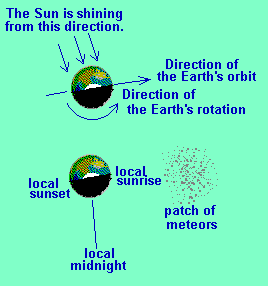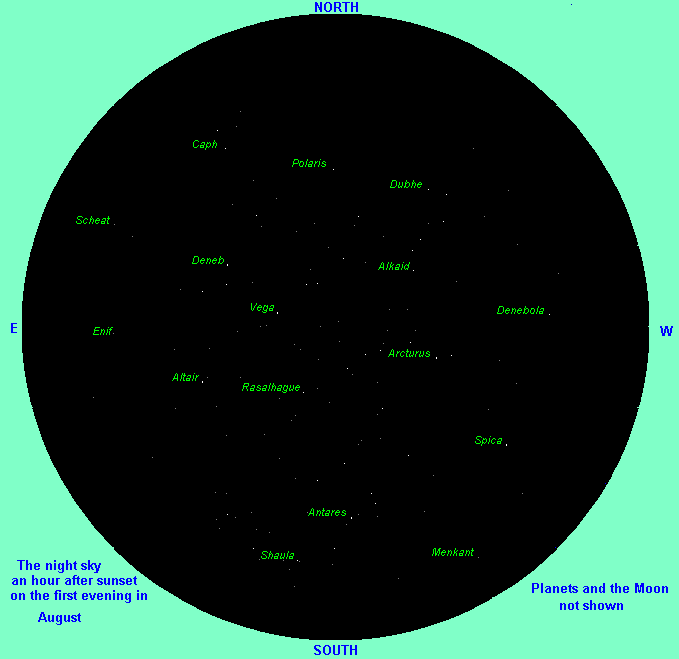This month is "Meteor Month"!
I call August "Meteor Month" because this is an excellent
month for watching objects from outer space invading our planet!  Tiny particles of dust and rock (leftover from the formation of
the Solar System) are constantly falling to Earth but most of
them go unseen because the material is so small. The larger ones,
however, produce "shooting stars". On an average night,
on no particular date, you should be able to see about ten naked-eye
meteors per hour. That's not very many. However, when the Earth
passes through a comet's tail or the debris left by a long dead
comet, the number of meteors seen is greatly increased. We entered
the debris of a comet late last month (as we do every year) and
we will continue passing through that debris for a few more weeks.
So this month is a great time to look for meteors!
Tiny particles of dust and rock (leftover from the formation of
the Solar System) are constantly falling to Earth but most of
them go unseen because the material is so small. The larger ones,
however, produce "shooting stars". On an average night,
on no particular date, you should be able to see about ten naked-eye
meteors per hour. That's not very many. However, when the Earth
passes through a comet's tail or the debris left by a long dead
comet, the number of meteors seen is greatly increased. We entered
the debris of a comet late last month (as we do every year) and
we will continue passing through that debris for a few more weeks.
So this month is a great time to look for meteors!
While in space these bodies are called meteoroids. There is no real difference between a meteoroid and an asteroid but most folks reserve the word "asteroid" for the really big ones. Indeed, asteroids are often called "minor planets".
When meteoroids enter the Earth's atmosphere they become meteors. They enter the atmosphere at very high speed (72 kilometers per second) producing a great deal of heat by friction with the air. This heat is so intense that it ionizes the atoms and molecules in the air surrounding the meteor, causing the air to glow by incandescent light. [This "incandescent light" is the same "hot light" produced in an incandescent lightbulb.] An average meteoroid becomes a meteor at about 115 kilometers above the Earth's surface and it usually burns out at an altitude of about 70 kilometers as it breaks up into tiny particles called micrometeors.
The biggest meteors make it all the way to the Earth's surface and we call them meteorites. Scientists collect these rare rocks for further study. Based upon sophisticated chemical analysis (often involving isotopes), these meteorites are classified into certain "families" and their likely "home" (asteroid, planet, etc.) determined. Of course, amateurs also collect them. The odds of you finding a meteorite are very, very small but the odds of you seeing a meteor are very, very, good - especially this month.
Your chances of seeing a meteor are increased after (local) midnight. Here's why.
|
This image shows a view of Earth as seen above its North Pole.
The Earth moves counterclockwise in its orbit (from left to right
in this image) and also rotates counterclockwise. Notice that
sunrise is to the right, in the same direction as the Earth's
orbital motion, but sunset is on the other side of the Earth.
Before midnight the observer will be on the side of the Earth opposite its path and the only meteors seen will be those that have spiraled into the Earth's gravity well and have been swept in from behind the Earth's orbit. After local midnight the Earth has rotated and presents its sky to the forward facing part of Earth's path so meteoroids strike it directly. If you understand why bugs get splattered on a car's front instead of its back, you'll understand why more meteoroids hit the "after midnight" side of the Earth than the "before midnight" side of the Earth. |

|
As the Earth enters a field of meteoroids they seem to enter the Earth's atmosphere from a certain part of the sky called the radiant. This is really a matter of perspective because the meteoroids are not really coming from a single point in space. Instead, the Earth intercepts the meteoroids in a series of parallel paths that give the effect of having come from a single point in the sky. [This point is like the one you see when looking at the parallel lines of a road's edge or a railway's rails as they appear to meet in the distance.]
The best meteor showers of the year are the Perseids. They start(ed)
around July 23 and end around August 20th. At their peak, on the
night of August 11th-12th, you can expect to see nearly one Perseid
meteor a minute! The Perseids are a rich and consistent meteor
shower that are part of the comet Swift-Tuttle. You should plan
to stay up late on the nights around August 12th. Or, better yet, get up several hours before sunrise so you can enjoy
these fantastic objects.
These showers will appear to radiate from the constellation of
Perseus. This constellation lies midway between Polaris (the North
Star) and Taurus the Bull. I don't think there's any reason
for me to draw you a sky map. You'll see what I mean. Just look
straight up (maybe a little eastward) a few hours before sunrise
and you'll see meteors hurtling out of Perseus! (Remember - this area of the sky rises AFTER midnight so you will not see it on the map I give you for August because our monthly maps are for the night sky soon after sunset.)
The Delta Aquarids meteor showers are not as spectacular as the Perseids. These showers began around mid-July and will end within the first week of August. Unlike the Perseids, these are fairly faint meteors. Frankly, I wouldn't try these as your first meteor shower. You'd be disappointed. As showers go, the Delta Aquarids are a complicated series of showers. Its relatives include the Alpha Capricornids (which peak on August 1st), the Southern Iota Aquarids (which peak on August 6th) and the Northern Iota Aquarids (which peak on August 25th). As these names imply, their radiants are in the constellations of Aquarius and Capricorn. These constellations follow the easily identified constellation of Sagittarius (which follows very easily found Scorpius) and this area of the night sky rises (from the eastern horizon) soon after sunset. That makes it easy for amateur astronomers who cannot stay up too late (or get up too early) but, as I explained before, premidnight is not the best time to see meteors. Regardless, have a look while you wait for Perseus to rise.
|
Your sky map for the month of AugustHere's a map of the clear, night sky as seen from the center of the USA on the first evening of this month, an hour after sunset. Specifically, this is the view of a clear sky from a latitude of 37N. Star-gazers farther north, such as in Minneapolis, Chicago and most of Europe, will have more of the northern sky visible and the southern sky will be obscured by the horizon. Vice versa for those who are farther south. The stars will not change position relative to each other, however, throughout the month, the Moon and planets will wander, so they are not shown. Only objects of magnitude 4.0 and brighter are displayed. Here's a reverse color image of the map that will be easier on your printer. |  |
Saturn's moon Enceladus was discovered on the 28th of August 1789 by William Herschel.
On the night of August 5th 1864, Giovanni Donati made the first spectroscopic observations of a comet. He found mysterious bands in this comet's spectrum that we now know are produced by molecular carbon.
On August 18, 1868 Norman Lockyer discovered helium in the Sun's spectrum. Actually, on that day he discovered the bands of an unknown element in the Sun's spectrum and named that new element "helium" after the sun-god "Helios". Years later, earthbound helium was isolated and its spectrum confirmed Lockyer's discovery.
Asaph Hall of the US Naval Observatory discovered Mars' small satellite, Deimos, on the 11th of August 1877. Six days later, August 17th 1877, he found Mars' other moon Phobos!
The first photograph of the Earth was taken from orbit by Explorer 6 on August 7th 1959.
On August 7th 1996, NASA scientists announced that they had found structures and chemicals in the Martian meteorite ALH84001 suggesting these could be Martian microfossils. This "evidence" has been disputed and most experts in the field believe the data is inconclusive (and another very good reason to visit Mars).
I hope you found the Night Sky this Month to be helpful and educational. I invite you to return here monthly for new information.